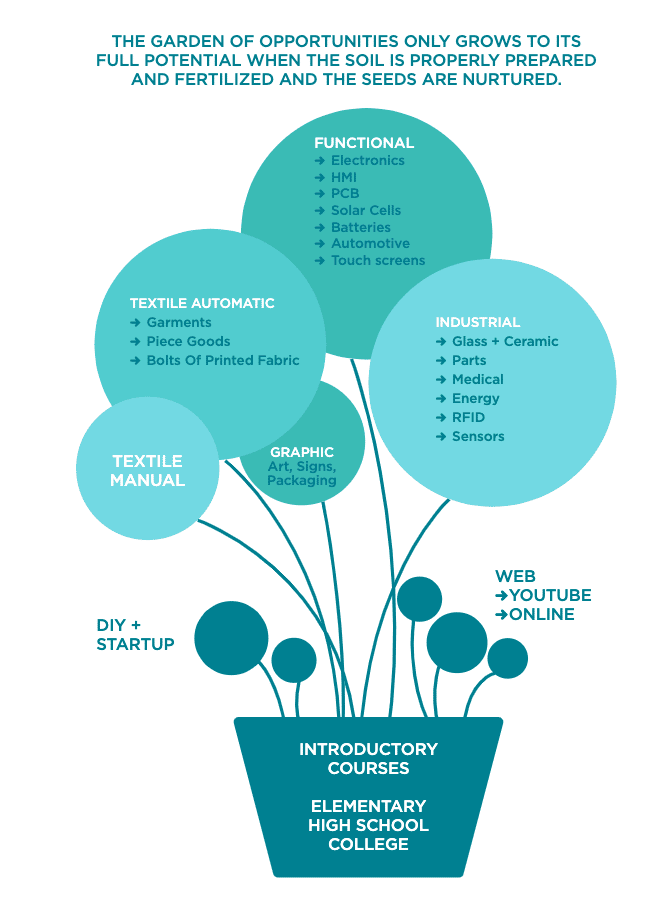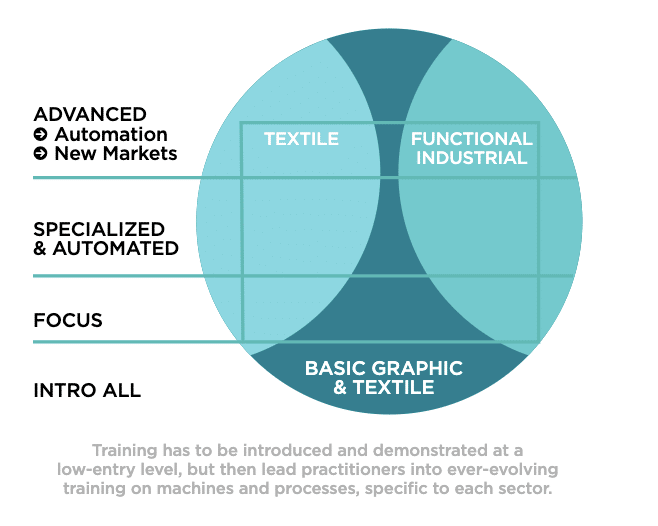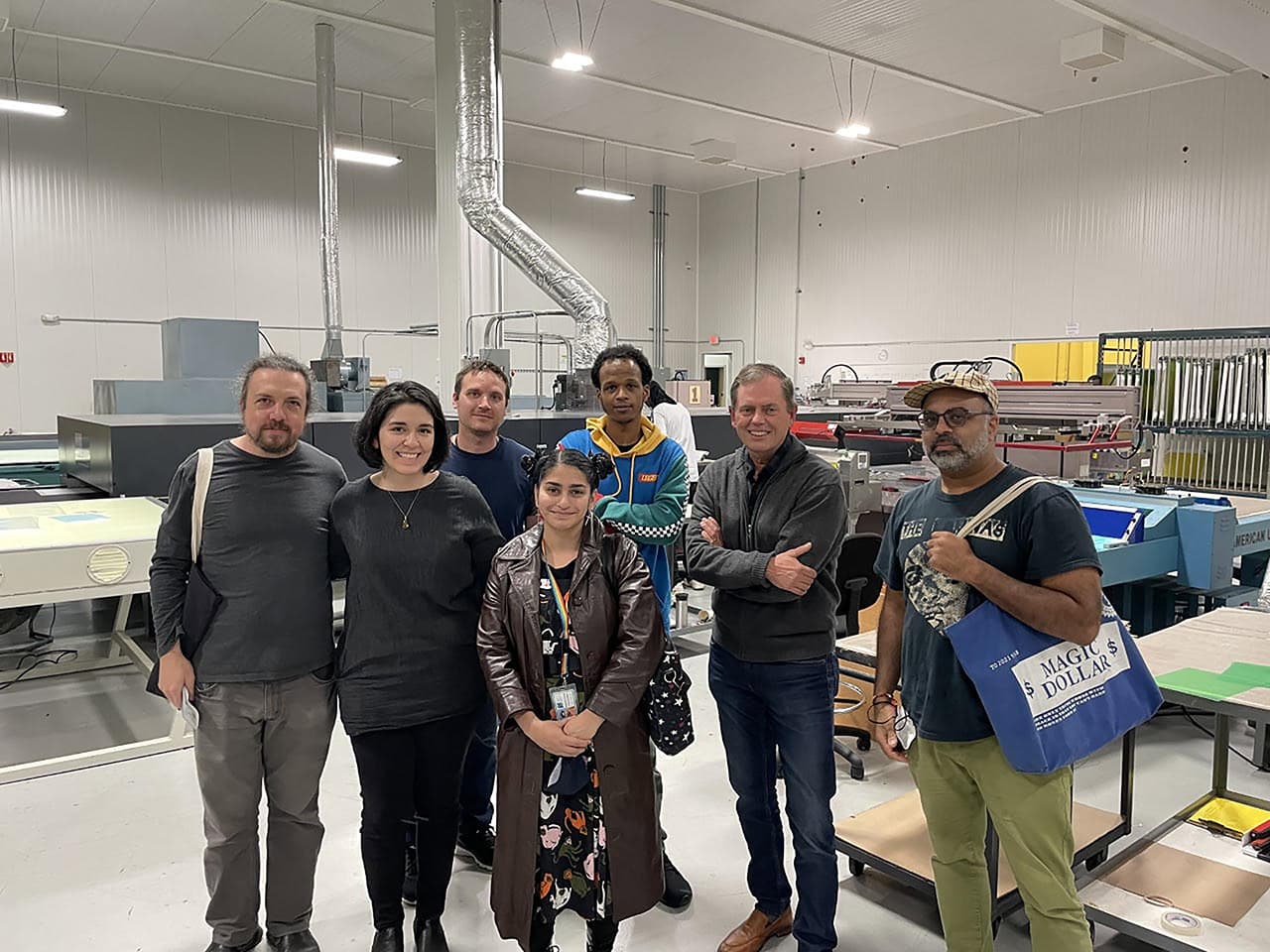WITH 2023 UPON US, we’re almost a quarter way through the new century. How did that happen? The long-predicted demise of screen printing has yet to materialize – neither did flying cars – but it seems educational initiatives and promotion of the process and technology have suffered in the last 20 years. It’s ironic that literally 6,950,000 results pop up on Google when I search “How to Screen Print,” but a quick glance proves the truth behind the Dunning- Kruger effect and the challenge to our industry: a public perception of a simplistic, old-fashioned, handcrafted printing method vs. a multifaceted manufacturing technology that uses sophisticated automatic
Growth and success are elusive for many screen printing companies. Not through lack of work, supplies, or capital, but due to a chronic shortage of people who know which part of the squeegee goes in the ink, how to get to that point in the process, and what to do after. Older workers are retiring en masse, this guy included, making the standard screen printing educational option of “learning on the job” much harder.
Unicorn Hunting
Finding trained and job-ready young ones is a challenge, right up there with unicorn hunting. Through the modern wonder that is YouTube, would-be screen printers can easily dive in and “master” the process, or at least figure out the rubbery part sits in the paint. But graduating from YouTube University with a degree in silk screening doesn’t always help commercial operators find even partially trained workers. What to do?
Readers and listeners to past “Art, Ad, or Alchemy?” installments have met practitioners who are part of the old wave/new wave of screen printers – textile printers, electronics printers, makerspace operators, and even gig poster squeegeedraggers. I always ask how people got into SP and got good at it, and it’s more or less the same story: a chance introduction, an immediate fascination with the process and the results, and then a lifelong commitment to learning and pushing the technology to create a better product more efficiently and economically. YouTube, Google, and now TikTok might help a newbie, but an inky mess on a kitchen table is far removed from even the most basic modern screen shop. And the best intentions of anyone can be crushed by failure. That’s the unfortunate result of relying on YouTube U as a prep school for new screen printers. I think it turns off more people than it recruits. We need a different approach. Correction: approaches. Plural.

Curious, Creative, and Just A Bit Crazy
Today’s guest on “Art, Ad, or Alchemy?” Episode #13 is Edward Cook, recently retired head of ECI Technologies, past chair of SGIA/PU, Screen Printing Editorial Advisory Board member, and a screen printer who sees one of the main challenges to the ongoing health of our print industry is the lack of talented young creatives coming in.
Advertisement
Ed has an idea to solve this and viewpoints on a number of other issues around screen printing. We get into it during the interview. He’s also an art lover and has donated his business skills to bettering his hometown of Torrington, Connecticut, by working with community nonprofits. Starting with a renovation of an abandoned storefront into 5 Points Gallery, they’ve literally revitalized their downtown core through championing creativity and art. Ed is a local boy who stayed, building up a tech business that’s a textbook example of how to compete with multinational offshore operations, creating good paying jobs in your own backyard, and bringing work back onshore, inventing new products and application techniques using screen printing, and producing them in North America. “We never said no to a customer with a crazy idea,” Ed tells me in the interview. That attitude spilled over. They didn’t stop with the downtown gallery. A gutsy bid for a surplus University of Connecticut 80-acre satellite campus is now on its way to becoming a regional art center.
Let’s bring this back to attracting workers to the screen printing industry. Ed has an idea, and I agree with him. One way we find those unicorn screen printers is we – as screen printers – start the search not in the help wanted section, but earlier, in local schools, and specifically the art programs, in high schools and colleges. Introduce the young people to the process through shop visits, and help establish screen printing courses in schools and in local makerspaces or post-graduate studios. Listen to the podcast. There’s more to Ed’s story, and hopefully we can find others who want to help push things forward.

If we look around the industry today, we see three Cs on display in most of the leaders and shop owners: Curious, Creative, and just a bit Crazy. These traits can be found in lots of art students, as well, who generally migrate to art as a refuge from a bland boring world that wants them to become worker drones in drudge jobs. Graduating high school or college with a major in art, in some cases, just means they hang out in their parents’ basement and get a job as a barista or bartender. In many cases, the degree never gets used. However, for some, getting introduced to screen printing gives them an outlet that provides a vehicle for their creativity, and most importantly, a link to economic activity they can realize immediately. Screen shops are using the latest design programs, making products used in day-to-day activities, and running production equipment that’s infinitely challenging and cutting edge.
This conversation with Ed is a starting point. In a world of TikTok and six-second reels, and even shorter attention spans, we have to find a way to reach the youth outside the industry, and then, when they’re inside, figure out how to deliver levels of training based on what they’re printing and what equipment they’re using. If the medium is the message, then we have to incorporate the smartphone and social media. We can’t abandon in-depth technical articles like SGIA used to provide, but we must update the delivery systems.
Screen printing is a really big tent. We’ve got people like Ed Cook or last month’s guest Dr. Julie Ferrigno who makes electronic and medical gizmos. We’ve got the MADE Lab guys who print shirts. We’ve got Luther Davis up in Brooklyn at powerhousearts.org printing fine art, or Gemma at monostereo.cat printing rock posters. All these subsections are different, yet linked by the squeegee, the mesh, and the stencil. And businesses in each subsection have different training requirements as they evolve and grow from manual printing into higher and higher levels of automation.
Advertisement

There’s no “one size fits all” solution, but people like Ed Cook are doing things in their community to help, and I’m sure many other readers and listeners have ideas around this, too. Let’s hear what you’ve got.
“You know that you’re over the hill, when your mind makes a promise that your body can’t fill … ” Bet you didn’t know us “retired” types have a theme song. It’s Little Feat’s “Old Folks Boogie.” Let’s hope it’s not prophetic.
My idea of retirement is hitting Impressions Expo in Long Beach in January and live printing posters for three days with the Ink Kitchen crew. Cool souvenir poster, all proceeds matched by SanMar going to a local charity. Drop by and let’s talk squeegee.


 Case Studies2 months ago
Case Studies2 months ago
 Art, Ad, or Alchemy2 months ago
Art, Ad, or Alchemy2 months ago
 Andy MacDougall2 months ago
Andy MacDougall2 months ago
 Columns4 weeks ago
Columns4 weeks ago
 Editor's Note3 weeks ago
Editor's Note3 weeks ago
 Marshall Atkinson3 weeks ago
Marshall Atkinson3 weeks ago
 Thomas Trimingham2 months ago
Thomas Trimingham2 months ago
 Case Studies4 weeks ago
Case Studies4 weeks ago


















